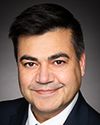It's a good question.
It connects back to Mr. Lobb's question about what drives our decisions about what we're going to do with all of this citizen science data, I think, at the end of the day, our organization exists to conserve birds and to recover these birds that are part of this biodiversity collapse.
We started today by telling you that we've lost three billion birds in North America since 1970. Those birds that you're describing, that you're seeing in Toronto, in Mississauga, we want you to be able to continue to see into the future, but the trends aren't looking good.
All of our citizen science programming is set up in such a way that the outcomes can influence conservation.
Just to give you one example, just recently, with the help of the federal government, we launched Canada's network of key biodiversity areas. These are basically like the crown jewels for biodiversity in Canada. These are the most important hot spots for biodiversity in Canada. We and our partners are able to map out where those places are directly because of citizen science.
Thanks to citizen science, we've now mapped out these key biodiversity areas, and those areas are now directly informing, for example, Canada's 30 by 30 target, which the world just agreed to at COP15. These are direct conservation impacts—real-world conservation impacts—that the citizen science data is having.





